Drone Laws in Connecticut

Paying attention to everything the FAA has put forth since their rules and regulations were initially put into full effect is crucial for all drone fliers. Although, do you know the laws and regulations related to drones in your state, as well?
Learn All The Drone Rules & Regulations
This article will give a brief overview of the laws in your state, but we can’t keep cover all the minutae in only two thousand words. That’s why we highly recommend that you do some research on your own time and, ideally, enroll in a professional course if you’re actually looking to get certified. Though there’s lots of options for learning more about drone laws, we highly recommend the#1 Rated Professional Course: Drone Pilot Ground School. Get $50 Off as a Dronethusiast reader, just click the link and sign up. It’s a great way to learn about drone laws and piloting that’s cheaper than most of its competition, you can purchase it once and own it forever and they’re constantly updating their professional training.
Flying Over Connecticut
Connecticut has a large number of beautiful state parks that are perfect for drone flight when the weather calls for it. Unfortunately, however, Connecticut state parks are all a no-go zone.
Finding a safe, legal area to fly in Connecticut is a bit of a battle at the moment, thanks to the conflict between the FAA and the Connecticut Department of Energy and Environmental Protection, also known as DEEP. The conflict stems from the rules and regulations set forth by the FAA.
One place we did find where it’s legal to fly, however, is Lock 12 Historical Park in Cheshire! Lock 12 Historical Park is separate from the Farmington Canal Trail, so make sure you keep that in mind before you go exploring with your drone. It’s a quiet, peaceful area with an abundance of color that will make your photos and videos glow.

Though Mount Monadnock can be found on the divide between the Merrimack River watersheds and the Connecticut River, so you’re technically still in Connecticut. The mount was created from an out of control fire initially meant to scare away wolves, burning all the trees. Today, it has a 3800-foot peak that is perfect for drone flight.
The Registering Process in Connecticut
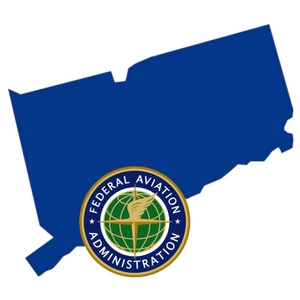
The Federal Aviation Administration (FAA) requires that all Small Unmanned Aircraft Systems (UAS) owners follow strict regulations and laws. You will need to file your name, home address and your email address as a start.
From there, you will receive a Certificate of Aircraft Registration and Proof of Ownership. These will include an identification number for your aircraft. You must have this number displayed on your drone at all times. The number will be valid for up to 3 years.
All aircraft that weighs more than 0.55 pounds, or 250 grams, and less than 55 pounds, or 25 kilograms, must be registered. This also includes any added payloads, such as an onboard camera.
You must be at least 13-years-old in order to register and, effective December 21st, 2015, all newly purchased or made drones must be registered before their first flight. You are able to register through a paper-based process, but you can also do so online by clicking here.
Proximity to Airports in Connecticut
As a general rule of thumb, and in accordance with the law from the FAA, you may not fly within a 5-mile radius of any airport. In 2012 the FAA enacted the Modernization and Reauthorization Act which requires hobbyist drone operators, meaning residential, to contact air traffic control and/or airport management if they are operating within a 5-mile radius of any local airport.
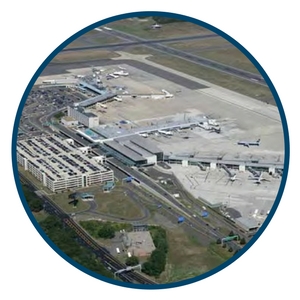
This is enacted nationwide, not only in Connecticut, under Part 101 of the Act, being Special Rule for Model Aircraft, to ensure that drone operations under unsafe conditions are disapproved before the drone can be launched.
Regardless of the local airport you will be flying near, and possibly breaching airspace, you will need to contact either the airport air traffic control tower or the airport operator.
You will need to establish an agreed-upon operating procedure with airport air traffic or the airport operator and answer a couple of questions. For example, questions relating to how long you are going to be flying for.
Unique Drone Laws in Connecticut
At this time of writing, all of the legal information listed below is deemed as accurate as possible and fully in effect.
SB 975 – Public Act No. 17 – 15
AN ACT CONCERNING MUNICIPALITIES AND UNMANNED AIRCRAFT.
Be it enacted by the Senate and House of Representatives in General Assembly convened:
Section 1. (NEW) (Effective from passage) (a) As used in this section, “commercial unmanned aircraft” means an aircraft operated remotely by a pilot in command holding a valid remote pilot certificate with a small unmanned aircraft systems rating issued by the Federal Aviation Administration.
(b) No municipality shall enact or enforce an ordinance or resolution that regulates the ownership, possession, purchase, sale, use, transportation or operation of any such aircraft, except as otherwise authorized by state and federal law, and to the extent they do not conflict with policies and procedures adopted by the Connecticut Airport Authority. Notwithstanding the provisions of this section, any municipality that is also a water company, as defined in section 25-32a of the general statutes, may enact and enforce ordinances or resolutions that regulate or prohibit the use of operation of private and commercial unmanned aircraft over such municipality’s public water supply and Class I or Class II land, as described in section 25-37c of the general statutes, provided such ordinances or resolutions do not conflict with federal law or policies and procedures adopted by the Connecticut Airport Authority.
Approved June 13, 2017
Other Legal Issues With Drones in Connecticut
At this time of writing, there are currently a number of bills in circulation within the state of Connecticut surrounding drones.
Department of Energy & Environmental Protection – Use of Remote Controlled Aircraft or “Drones”
The use of remote controlled model aircraft or “drones” is prohibited at Connecticut State Parks, State Forests or other lands under the control of the Department of Energy and Environmental Protection, unless specifically authorized by the Commissioner in a Special Use License.
Remote control aircraft and drones fly at low altitudes, and rely on a fuel or battery motor to stay aloft. Failure of the motor or other equipment will result in an uncontrolled descent, which could result in injury to others or damage to state or personal property. Additionally, the operation of these aircraft by an untrained pilot also creates risk of injury and/or property damage. As there is currently no licensing requirement for pilots, there is no reliable mechanism for DEEP to be assured of pilot competence. This type of potentially hazardous activity is prohibited by our Park and Forest Regulations (Regulations of CT State Agencies §23-4-1 (o)).
The operation of these aircraft are noisy. Activities that create noise which infringes on the ability of other park goers to enjoy their visit to the park or forest is prohibited by our regulations at §23-4-1(x). Impacts of this noise on wildlife in our parks and forests is another concern. Activities that are disruptive to wildlife are prohibited by our regulations at §23-4-1(b).
If you have questions or need additional information on Connecticut State Parks and Forests, please contact the State Parks Division by e-mail at deep.stateparks@ct.gov or by phone at 860-424-3200.
SB No. 6195 – Proposed Various Regulations
AN ACT CONCERNING THE USE OF AN UNMANNED AERIAL VEHICLE.
Be it enacted by the Senate and House of Representatives in General Assembly convened:
That the general statutes be amended to (1) clarify that all existing crimes include the use of an unmanned aerial vehicle to commit the crime, (2) clarify that tortious invasion of privacy includes the use of an unmanned aerial vehicle to commit the tort, (3) establish the crime of weaponization of an unmanned aerial vehicle, (4) clarify that imagery obtained using an unmanned aerial vehicle is protected free speech provided the imagery is obtained under circumstances where no reasonable expectation of privacy exists, and while operating pursuant to federal law, (5) prohibit the damaging of unmanned aerial vehicles, (6) prohibit the interference with persons operating or assisting with the operation of unmanned aerial vehicles, (7) recognize that the regulation of airspace, airmen and aircraft falls within the sole and exclusive jurisdiction of the federal government, (8) prohibit municipalities or state agencies from regulating airspace, airmen and aircraft, (9) clarify that municipalities and state agencies may regulate land use, zoning and laws of general applicability, (10) limit the use of an unmanned aerial vehicle by law enforcement and other state agencies, and (11) establish retention and destruction requirements for information collected by law enforcement using unmanned aerial vehicles.
HB 7260 – The Use and Regulation of Drones
AN ACT CONCERNING THE USE AND REGULATION OF DRONES.
Be it enacted by the Senate and House of Representatives in General Assembly convened:
Section 1. (NEW) (Effective October 1, 2017) (a) For the purposes of this section:
(1) “Law enforcement officer” means (A) a special policeman appointed under section 29-18 of the general statutes, or (B) an officer, employee or agent of (i) the Division of State Police within the Department of Emergency Services and Public Protection, (ii) a special police force established pursuant to section 10a-156b of the general statutes, or (iii) a municipal police department; and
(2) “Unmanned aerial vehicle” means any contrivance used or designed for navigation of or flight in air that is power-driven and operated without the possibility of direct human intervention from within or on the contrivance.
(b) Except as otherwise provided by law, no person, except a law enforcement officer performing his or her duties, shall operate or use any computer software or other technology, including, but not limited to, an unmanned aerial vehicle, that allows such person, when not physically present, to release tear gas or any like or similar deleterious agent or to remotely control a deadly weapon, as defined in section 53a-3 of the general statutes, or an explosive or incendiary device, as defined in section 53-206b of the general statutes.
(c) Any person who violates subsection (b) of this section shall be guilty of a class C felony.
Sec. 2. (NEW) (Effective October 1, 2017) (a) A person is guilty of reckless endangerment with an unmanned aerial vehicle in the first degree when, with extreme indifference to human life, such person recklessly collides an unmanned aerial vehicle into an aircraft or a motor vehicle, creating a risk of serious physical injury to another person. For purposes of this section, “recklessly” and “serious physical injury” have the same meanings as provided in section 53a-3 of the general statutes, “unmanned aerial vehicle” has the same meaning as provided in section 1 of this act, “aircraft” has the same meaning as provided in section 15-34 of the general statutes, as amended by this act, and “motor vehicle” means a passenger or commercial motor vehicle or a motorcycle, as defined in section 14-1 of the general statutes, and includes construction equipment, agricultural tractors and farm implements.
(b) Reckless endangerment with an unmanned aerial vehicle in the first degree is a class A misdemeanor.
Sec. 3. (NEW) (Effective October 1, 2017) (a) A person is guilty of reckless endangerment with an unmanned aerial vehicle in the second degree when such person recklessly collides an unmanned aerial vehicle into an aircraft or a motor vehicle, which creates a risk of physical injury to another person. For purposes of this section, “recklessly” and “physical injury” have the same meanings as provided in section 53a-3 of the general statutes, “unmanned aerial vehicle” has the same meaning as provided in section 1 of this act, “aircraft” has the same meaning as provided in section 15-34 of the general statutes, as amended by this act, and “motor vehicle” means a passenger or commercial motor vehicle or a motorcycle, as defined in section 14-1 of the general statutes, and includes construction equipment, agricultural tractors and farm implements.
(b) Reckless endangerment with an unmanned aerial vehicle in the second degree is a class B misdemeanor.
Sec. 4. Subdivision (5) of section 15-34 of the general statutes is repealed and the following is substituted in lieu thereof (Effective October 1, 2017):
(5) “Aircraft” means any contrivance used or designed for navigation of or flight in air, including (A) airplanes, meaning power-driven fixed-wing aircraft, heavier than air, supported by the dynamic reaction of the air against their wings, (B) gliders, meaning heavier than air aircraft, the free flight of which does not depend principally upon a power-generating unit, and (C) rotorcraft, meaning power-driven aircraft, heavier than air, supported during flight by one or more rotors. “Aircraft” does not include an unmanned aerial vehicle, as defined in section 1 of this act.
Sec. 5. Subsection (a) of section 53a-189a of the general statutes is repealed and the following is substituted in lieu thereof (Effective October 1, 2017):
(a) A person is guilty of voyeurism when, (1) with malice, such person knowingly photographs, films, videotapes or otherwise records the image of another person (A) without the knowledge and consent of such other person, (B) while such other person is not in plain view, and (C) under circumstances where such other person has a reasonable expectation of privacy, (2) with intent to arouse or satisfy the sexual desire of such person or any other person, such person knowingly photographs, films, videotapes or otherwise records the image of another person (A) without the knowledge and consent of such other person, (B) while such other person is not in plain view, and (C) under circumstances where such other person has a reasonable expectation of privacy, (3) with the intent to arouse or satisfy the sexual desire of such person, commits simple trespass, as provided in section 53a-110a, and observes, in other than a casual or cursory manner, another person (A) without the knowledge or consent of such other person, (B) while such other person is inside a dwelling, as defined in section 53a-100, and not in plain view, and (C) under circumstances where such other person has a reasonable expectation of privacy, or (4) with intent to arouse or satisfy the sexual desire of such person or any other person, such person knowingly photographs, films, videotapes or otherwise records the genitals, pubic area or buttocks of another person or the undergarments or stockings that clothe the genitals, pubic area or buttocks of another person (A) without the knowledge and consent of such other person, and (B) while such genitals, pubic area, buttocks, undergarments or stockings are not in plain view. For purposes of this subsection, “not in plain view” includes a view not otherwise obtainable that is made possible through the use of (i) technology that is electronic, as defined in section 1-331, or (ii) an unmanned aerial vehicle, as defined in section 1 of this act.
Sec. 6. Subdivision (8) of subsection (a) of section 54-280 of the general statutes is repealed and the following is substituted in lieu thereof (Effective October 1, 2017):
(8) “Offense committed with a deadly weapon” or “offense” means: (A) A violation of subsection (c) of section 2-1e, subsection (e) of section 29-28, subsections (a) to (e), inclusive, or (i) of section 29-33, section 29-34, subsection (a) of section 29-35, section 29-36, 29-36k, 29-37a or 29-37e, subsection (c) of section 29-37g, section 29-37j, subsection (b), (c) or (g) of section 53-202, section 53-202b, 53-202c, 53-202j, 53-202k, 53-202l, 53-202aa or 53-206b, subsection (b) of section 53a-8, section 53a-55a, 53a-56a, 53a-60a, 53a-60c, 53a-72b, 53a-92a, 53a-94a, 53a-102a, 53a-103a, 53a-211, 53a-212, 53a-216, 53a-217, 53a-217a, 53a-217b or 53a-217c or section 1 of this act, or a second or subsequent violation of section 53-202g; or (B) a violation of any section of the general statutes which constitutes a felony, as defined in section 53a-25, provided the court makes a finding that, at the time of the offense, the offender used a deadly weapon, or was armed with and threatened the use of or displayed or represented by words or conduct that the offender possessed a deadly weapon;
Sec. 7. (NEW) (Effective October 1, 2017) (a) For the purposes of this section:
(1) “Unmanned aerial vehicle” means unmanned aerial vehicle, as defined in section 1 of this act;
(2) “Law enforcement officer” means law enforcement officer, as defined in section 1 of this act; and
(3) “Law enforcement agency” means the special police appointed under section 29-18 of the general statutes, the Division of State Police within the Department of Emergency Services and Public Protection, the special police forces established pursuant to section 10a-156b of the general statutes, or any municipal police department.
(b) (1) No law enforcement officer shall operate an unmanned aerial vehicle, except under one or more of the following circumstances:
(A) A judge of the Superior Court or judge trial referee has issued a warrant in accordance with section 54-33a of the general statutes authorizing the use of an unmanned aerial vehicle;
(B) The individual who will be the subject of the information collected by the operation of an unmanned aerial vehicle has given advance written consent to such operation;
(C) The owner of the property that will be the subject of the information collected by the operation of an unmanned aerial vehicle has given advance written consent to such operation;
(D) The law enforcement officer has probable cause to believe that a criminal offense has been, is being or will be committed and exigent circumstances exist that make it unreasonable for the law enforcement officer to obtain a warrant authorizing the use of an unmanned aerial vehicle;
(E) The operation is pursuant to training activities conducted by the law enforcement officer while on property owned or leased by the United States, this state or a municipality and does not occur in an area that is substantially populated; or
(F) The operation is used to reconstruct or document a specific crime or accident scene.
(2) The provisions of this subsection do not apply to (A) any property owned or leased by the federal or state or a municipal government, including, but not limited to, a public park, sidewalk or street, or (B) an individual on such property described in subparagraph (A) of this subdivision.
(c) An individual or privately owned property shall be considered to be the subject of information collected by the operation of an unmanned aerial vehicle if the information allows the identity of the individual or the privately owned property to be ascertained or if the law enforcement officer operating the unmanned aerial vehicle acknowledges that such individual or such property was the subject of the information.
(d) Information that was collected through the operation of an unmanned aerial vehicle that concerns an individual or privately owned property that was the subject of a warrant may be retained pursuant to the warrant.
(e) Information that was collected through the operation of an unmanned aerial vehicle pursuant to advance written consent under subparagraph (B) or (C) of subdivision (1) of subsection (b) of this section may be retained pursuant to the terms specified in such advance written consent.
(f) (1) Information that was collected through the operation of an unmanned aerial vehicle pursuant to subparagraph (D), (E) or (F) of subdivision (1) of subsection (b) of this section that concerns an individual or privately owned property shall be reviewed by the law enforcement agency that collected the information not later than ninety days from the date of collection. The collected information shall be destroyed or modified pursuant to subdivision (2) of this subsection or retained pursuant to subdivision (3) of this subsection.
(2) If such information allows the identity of an individual or privately owned property to be ascertained and there is no probable cause to believe that an offense was committed by the individual or on the property, such law enforcement agency (A) shall destroy such information not later than forty-eight hours after such review, or (B) shall permanently modify such information so that the identity of such individual or such property cannot be ascertained, and, after such modification, may retain the modified information for a period of not more than five years from the date of collection and, after such retention, shall destroy the modified information.
(3) If such information allows the identity of an individual or privately owned property to be ascertained and there is probable cause to believe that an offense was committed by the individual or on the property, such law enforcement agency may retain such information for a period of not more than five years from the date of collection and, after such retention, shall destroy such information, except that, if a warrant is issued in accordance with section 54-33a of the general statutes based in part on such information, such information may be retained pursuant to the warrant.
(4) No information that was retained in violation of subdivision (2) or (3) of this subsection shall be admitted into evidence or otherwise considered by any court or agency, body or committee of this state or any municipality.
(g) (1) Not later than January 1, 2018, the Police Officer Standards and Training Council shall develop and promulgate a model policy that provides guidelines on the operation of an unmanned aerial vehicle by a law enforcement officer, including a weaponized unmanned aerial vehicle, and the destruction, modification and retention of information collected by such operation. Upon completion of such model policy, the council shall report such policy, in accordance with the provisions of section 11-4a of the general statutes, to the joint standing committees of the General Assembly having cognizance of matters relating to the judiciary and public safety.
(2) Each law enforcement agency that possesses for operation an unmanned aerial vehicle or authorizes a law enforcement officer to operate an unmanned aerial vehicle shall adopt and maintain a written policy that meets or exceeds the model policy developed by the Police Officer Standards and Training Council pursuant to subdivision (1) of this subsection and that includes a process for categorizing the types of such operations, before taking possession of such unmanned aerial vehicle or not later than thirty days after a law enforcement officer operates an unmanned aerial vehicle.
(h) Not later than January thirty-first of each year, each law enforcement agency that operated an unmanned aerial vehicle in the preceding calendar year shall prepare a report that includes, but need not be limited to: (1) The number of times the law enforcement agency operated an unmanned aerial vehicle in the preceding calendar year, (2) the type of such operation as categorized in the policy adopted pursuant to subdivision (2) of subsection (g) of this section, (3) whether the unmanned aerial vehicle was operated pursuant to a warrant, and (4) the number of times the type of information collected through the operation of an unmanned aerial vehicle provided reasonable and articulable suspicion that a criminal offense was being committed. The law enforcement agency shall make such report available on the law enforcement agency’s Internet web site or the Internet web site of the municipality served by the law enforcement agency.
AN ACT CONCERNING THE USE AND REGULATION OF DRONES.
SUMMARY
This bill criminalizes the operation or use of unmanned aerial vehicles (commonly called drones) that are weaponized, except by law enforcement officers in certain circumstances while performing their duties. The bill makes operating a weaponized drone a class C felony, punishable by up to 10 years in prison, up to a $10,000 fine, or both; and violators must register with the deadly weapon offender registry (see BACKGROUND) (§§ 1 & 6).
The bill also:
1. establishes two degrees of reckless endangerment with a drone that are both punishable as misdemeanors (§§ 2 & 3);
2. restricts when law enforcement officers may operate drones and requires them to follow certain protocols regarding the information they receive from such use (§ 7);
3. excludes drones from the statutes governing aircraft, which include, among other things, aircraft registration, tax treatment, accident investigation, and compliance with the Uniform Aircraft Responsibility Act (§ 4);
4. specifies that, for purposes of voyeurism crimes, a victim is “not in plain view” when the view is not otherwise obtainable and is made possible by using a drone or technology having electrical, digital, magnetic, wireless, optical, electromagnetic, or similar capabilities (see BACKGROUND) (§ 5);
5. requires the Police Officer Standards and Training Council (POST) to (a) develop a model policy for drone operation, including weaponized drones, and treatment of records related to drone operations and (b) report the completed policy to the Judiciary and Public Safety committees (§ 7); and
6. requires law enforcement agencies to adopt policies that meet or exceed the policies POST develops and fulfill certain annual reporting requirements (§ 7).
EFFECTIVE DATE: October 1, 2017
§ 1 — WEAPONIZED DRONES
The bill defines an “unmanned aerial vehicle” as any power-driven contrivance used or designed for navigation or flight and operated remotely from the outside (“drones”).
It creates a new crime, making it a class C felony, unless otherwise provided by law, to operate or use any computer software or other technology, including a drone, to (1) release tear gas or a similar deleterious agent or (2) remotely control a deadly weapon, explosives, or an incendiary device. (Drones so equipped are commonly described as weaponized or armed.) People convicted of this crime must register with the deadly weapon offender registry (see BACKGROUND). Failure to register is a class D felony punishable by imprisonment for up to five years, a fine of up to $5,000, or both.
The bill allows designated law enforcement officers to use drones while performing their duties, as described below (see LAW ENFORCEMENT USE OF DRONES).
§§ 2 & 3 — RECKLESS ENDANGERMENT WITH A DRONE
Under the bill, a person is guilty of reckless endangerment with a drone:
1. in the first degree, which is a class A misdemeanor, when, with extreme indifference to human life, he or she recklessly collides the drone into an aircraft or motor vehicle, creating risk of serious physical injury to another person and
2. in the second degree, which is a class B misdemeanor, when he or she recklessly collides a drone into an aircraft or a motor vehicle, creating risk of physical injury to another person (see BACKGROUND).
For these purposes, motor vehicles include passenger and commercial vehicles, motorcycles, construction equipment, tractors, and farm implements.
By law, a class A misdemeanor is punishable by up to one year in prison, up to a $2,000 fine, or both. A class B misdemeanor is punishable by up to six months in prison, up to a $1,000 fine, or both.
§ 7 — LAW ENFORCEMENT USE OF DRONES
The bill limits the circumstances in which law enforcement officers may operate drones, including weaponized drones, and retain the information collected by such operation. For these purposes, law enforcement officers include: (1) Department of Emergency Services and Public Protection (DESPP) -appointed special police officers for state property and (2) officers, employees, or agents of the State Police; municipal police departments; special campus police forces; and State Capitol Police. The bill specifies that these provisions do not apply to (1) government-owned or -leased property including public parks, sidewalks, or streets or (2) individuals on such property.
Drone Use With A Warrant or Written Consent
The bill permits a law enforcement officer to operate a drone only if:
1. a judge or judge trial referee has issued a warrant authorizing the drone’s use or
2. the individual, or property owner, who will be the subject of the information collected by the drone’s operation has given advance written consent to the operation.
A person or private property is considered to be the subject of information collected by the drone’s operation if the (1) information allows the person or property to be identified or (2) officer operating the drone acknowledges the person or property was the subject of the information.
Under the above circumstances, information collected through the drone’s operation may be retained pursuant to the (1) warrant or (2) terms specified in the consent.
Drone Use in Exigent Circumstances or for Training or Crime Reconstruction
The bill also permits a law enforcement officer to operate a drone only if the:
1. officer has probable cause to believe that a crime has been, is being, or will be committed and exigent circumstances make it unreasonable to obtain a warrant; or
2. drone is used (a) as part of law enforcement training activities conducted on state- or federal-owned or leased land that is not substantially populated or (b) to reconstruct or document a specific crime or accident scene (however, as noted above, the bill specifies that these provisions do not apply to government-owned or -leased property).
The bill requires the law enforcement agency that collected information in those circumstances to review the information within 90 days of its collection and then take certain actions depending on whether or not there is probable cause to believe an offense was committed.
If the reviewed information allows the person or property to be identified and there is no probable cause to believe that an offense was committed, the law enforcement agency must either (1) destroy the information within 48 hours of the review or (2) permanently modify the information so that the individual or property can no longer be identified. The law enforcement agency may retain the modified information for up to five years after it was collected and then must destroy it.
If the reviewed information allows the person or property to be identified and there is probable cause to believe that a crime was committed, the law enforcement agency may retain the information for up to five years after it was collected and then must destroy it. But if a warrant was issued in part on the information, it may be retained pursuant to the warrant.
The bill prohibits any information that was not destroyed, modified, or retained as required above to be admitted into evidence or otherwise considered by any state or local court, agency, body, or committee.
§ 7 — POLICIES AND REPORTING REQUIREMENTS
POST
By January 1, 2018, the bill requires POST to develop and promulgate a model policy that provides guidelines on (1) drone operation by law enforcement officers, including weaponized drones, and (2) the destruction, modification, and retention of information collected by the operation. Upon completion, POST must report the policy to the Judiciary and Public Safety committees.
Law Enforcement
Under the bill, law enforcement agencies that possess a drone or authorize a law enforcement officer to operate a drone must adopt and maintain written policies that meet or exceed the policy POST develops (1) before taking possession of the drone or (2) within 30 days of an officer operating the drone. The policies must include a process for categorizing the types of drone operations.
By January 31st each year, the bill also requires each law enforcement agency that operated a drone in the preceding calendar year to prepare a report that includes:
1. the number of times the agency operated the drone in the preceding year,
2. the type of operation as categorized by the agency’s drone policy,
3. whether the drone was operated pursuant to a warrant, and
4. the number of times and type of information collected through the drone’s operation due to a reasonable and articulable suspicion that a crime was being committed.
The law enforcement agency must make the report available on its website and the website of the municipality it serves.
BACKGROUND
Deadly Weapon and Deadly Weapon Offender Registry
By law, a “deadly weapon” is a weapon, whether loaded or unloaded, from which a shot may be discharged, or a switchblade knife, gravity knife, billy, blackjack, bludgeon, or metal knuckles (CGS § 53a-3).
By law, DESPP maintains a registry of people convicted, or found not guilty by reason of mental disease or defect, of an offense committed with a deadly weapon. A person must register if he or she (1) violated specified statutes or (2) committed any felony and the court finds that, at the time of the offense, the offender used a deadly weapon or was armed with and threatened to use, displayed, or represented by words or conduct that he or she possessed, a deadly weapon. Offenders must register for five years. The registry information is not a public record and is disclosable only to certain law enforcement personnel and other agencies (CGS § 54-280 et seq.).
Voyeurism
By law, a person commits the crime of voyeurism when he or she:
1. knowingly photographs, films, videotapes, or records the victim’s image maliciously or to satisfy his or her or another person’s sexual desire and the victim (a) is not in plain view, (b) has a reasonable expectation of privacy under the circumstances, and (c) does not know of, or consent to, the conduct;
2. trespasses in a way that is not casual or cursory to arouse or satisfy his or her sexual desire and the victim (a) is inside a dwelling and not in plain view, (b) has a reasonable expectation of privacy under the circumstances, and (c) does not know of, or consent to, the conduct; or
3. knowingly photographs, films, videotapes, or otherwise records another person’s genitals, pubic area, buttocks, or undergarments or stockings covering those areas to arouse or satisfy his or her or another person’s sexual desire and the (a) genitals, pubic area, buttocks, undergarments, or stockings are not in plain view and (b) victim does not know of, or consent to, the conduct.
By law, voyeurism is either a class D or class C felony depending on the circumstances. A first offense is a class D felony, but it a class C felony if the (1) victim is under age 16 or (2) offender has a prior conviction of certain sexual crimes. Any subsequent voyeurism conviction is a class C felony. Additionally, a person convicted of the type of voyeurism that involves satisfying a person’s sexual desire must, in certain circumstances, register as a sex offender for 10 years or life, depending on his or her prior convictions. Failure to register is a class D felony (CGS § 53a-189a).
Reckless Action and Serious Physical Injury
By law, a person acts “recklessly” when he or she is aware of and consciously disregards a substantial and unjustifiable risk that the result will occur or that the circumstance exists. The risk must be of such nature and degree that disregarding it constitutes a gross deviation from a reasonable person’s standard of conduct in the situation (CGS § 53a-3(13)).
By law, a “serious physical injury” is a physical injury that creates a substantial risk of death or that causes serious (1) disfigurement, (2) health impairment, or (3) loss or impairment of bodily organ function (CGS § 53a-3(4)).
HB 6450 – Stalking
AN ACT CONCERNING STALKING WITH AN UNMANNED AERIAL VEHICLE.
Be it enacted by the Senate and House of Representatives in General Assembly convened:
That sections 53a-181c to 53a-181e, inclusive, of the general statutes be amended to prohibit a person wilfully and repeatedly following or lying in wait for another person by using an unmanned aerial vehicle and thereby causing such other person to fear for his or her physical safety.
Statement of Purpose:
To prohibit a person from stalking another person by using an unmanned aerial vehicle.
FAQ on Connecticut Law and Drones
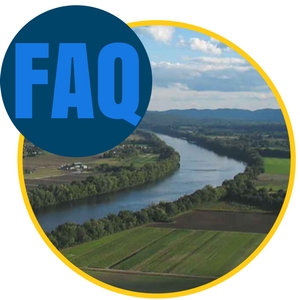
If you do not see your question, or an answer to it, listed below, feel free to get in touch with us and we’ll gladly give you one.
Is a drone/UAS considered the same as a model aircraft?
The United States Congress has defined and concluded that a model aircraft is only considered a drone or a UAS when the following points are met:
It’s flown for recreational purposes or as a hobby and not for any business or commercial reasons
It’s flown within visible distance, meaning being able to see it at all times, of the individual operating it
It’s capable of sustaining flight within the atmosphere, meaning that it can fly
If your model aircraft, regardless of whether or not you acquired it pre-built or built it yourself, meets the above points to your knowledge, it’s considered a drone/UAS.
What is the Small UAS Rule?
The Small UAS Rule requires those who have unmanned aircraft systems, or UAS, that weigh less than 55 pounds, payload included, to register their aircraft with the FAA. This only applies to recreational or hobby fliers and not commercial drone use, however.
Is the FAA’s Small UAS Rule still in effect?
Yes, it has been in effect from August 29th of 2016 and is still in effect at this time of writing.
Do I have to carry my Certificate of Aircraft Registration while flying my UAS at all times?
Yes, you must have the registration certificate from the FAA at all times during flight operation. In accordance with federal law, all UAS operators must show their certificate of registration to any local, state, or federal law enforcement officer when they are asked to do so.
What do I do for registration if my UAS is over the 55-pound limit?
If your UAS weighs more than 55 pounds, including payload, you will need to register it by clicking here.

Drone Laws in Connecticut
Knowing the laws, regulations, restrictions, etc., regarding drones in your state is extremely important. Remember to educate yourself, follow the rules, fly safely and responsibly, and have fun!

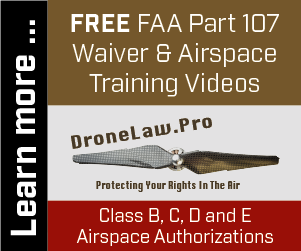

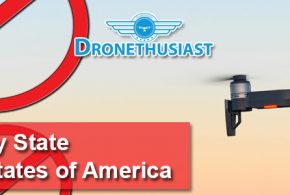
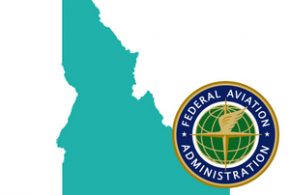
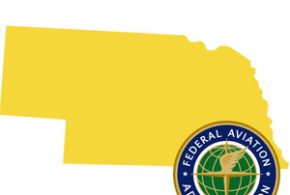

Hi, I have a Phantom 3 DJI Advanced and I would like to learn more.